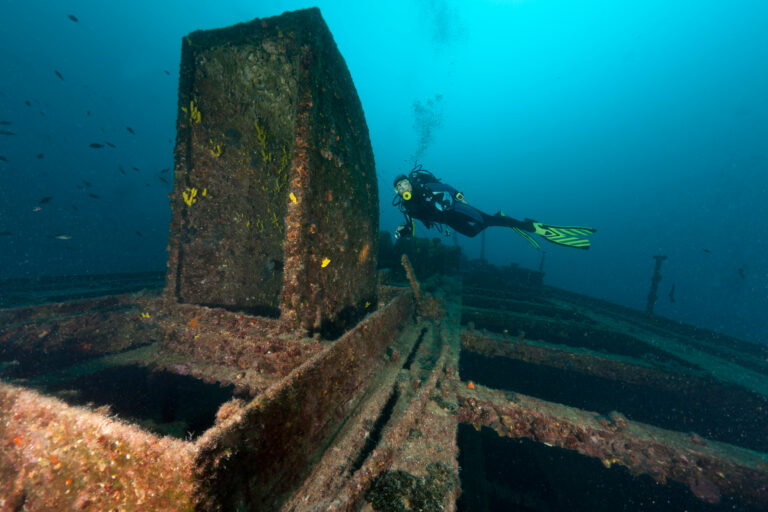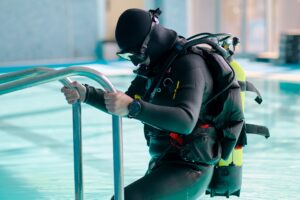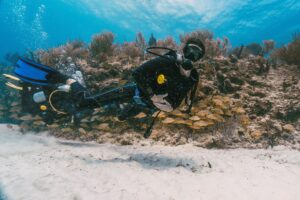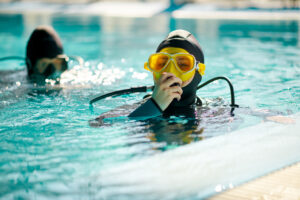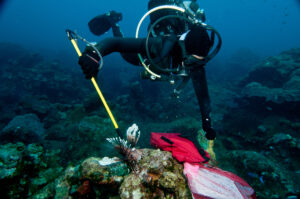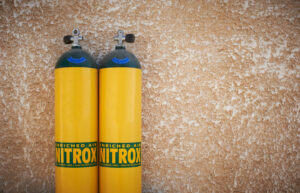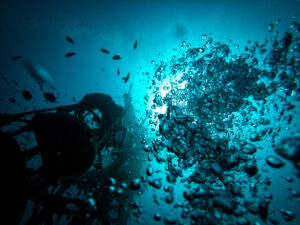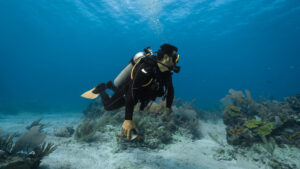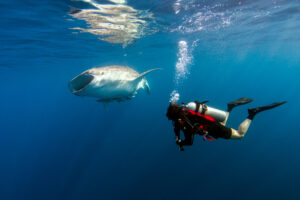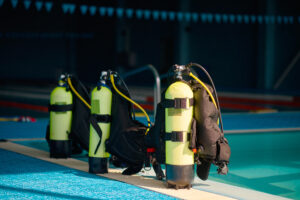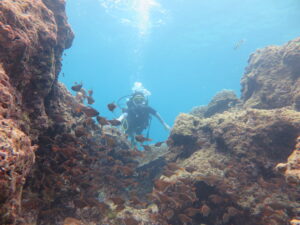What is a DIN Valve?
A DIN valve is a type of valve used in scuba diving equipment, specifically for connecting a scuba tank to a regulator. The term “DIN” stands for “Deutsches Institut für Normung,” which translates to the German Institute for Standardization. This institute is responsible for developing and maintaining the standards that define the specifications for these valves. DIN valves are known for their robust design and reliable performance, making them a popular choice among divers, particularly in Europe and in technical diving communities.
Historical Development
The development of the DIN valve dates back to the mid-20th century, originating from the need for safer and more reliable connections between scuba tanks and regulators. Before the advent of the DIN valve, most scuba tanks used yoke valves, also known as A-clamps, which were more prone to failure under high pressure conditions. The German Institute for Standardization introduced the DIN valve as a more secure alternative.
The introduction of the DIN valve marked a significant shift in scuba diving equipment standards. Early designs focused on creating a more secure and pressure-resistant connection. Over time, the DIN valve evolved, incorporating advancements in materials and manufacturing techniques to enhance its durability and performance. The adoption of the DIN valve in the diving industry was driven by its superior safety features, making it the preferred choice for technical and professional divers.
As scuba diving gained popularity worldwide, the DIN valve’s reputation for safety and reliability led to its widespread acceptance. By the late 20th century, many diving organizations and certification agencies recommended or mandated the use of DIN valves for certain types of diving, particularly those involving high-pressure gas mixes. Today, the DIN valve remains a standard component in modern scuba diving equipment, known for its enduring legacy of safety and performance.
Technical Specifications
DIN valves are characterized by their distinctive threaded design, which ensures a secure and leak-proof connection between the scuba tank and the regulator. The threads on a DIN valve are designed to match those on the corresponding regulator fitting, creating a tight seal that can withstand high pressure. This design is in contrast to yoke valves, which rely on a clamp mechanism that can be less secure under certain conditions.
A typical DIN valve consists of several key components, including the valve body, a threaded insert, an O-ring, and a handwheel for opening and closing the valve. The valve body is usually made from high-strength materials such as brass or stainless steel to withstand the rigors of underwater environments and high-pressure gas. The threaded insert is designed to match specific standards, with common types including DIN 200 and DIN 300, which denote the maximum working pressure of the valve in bar.
One of the primary advantages of the DIN valve is its ability to handle higher pressures than yoke valves. DIN 200 valves are rated for a maximum working pressure of 200 bar (approximately 2900 psi), while DIN 300 valves can handle up to 300 bar (approximately 4350 psi). This makes DIN valves suitable for technical diving applications where higher pressure gas mixes are used. The use of an O-ring in the threaded connection further enhances the seal, reducing the risk of leaks and improving overall safety.
In addition to their pressure-handling capabilities, DIN valves are also designed to meet specific international standards. The most commonly referenced standard for DIN valves is the ISO 12209 series, which outlines the requirements for the dimensions, materials, and performance of these valves. Compliance with these standards ensures that DIN valves provide a consistent and reliable performance, making them a trusted choice for divers around the world.
Functional Mechanism
The functional mechanism of a DIN valve is centered around its threaded connection, which provides a secure and pressure-resistant seal between the scuba tank and the regulator. When the regulator is screwed onto the valve, the threads engage, and the O-ring inside the valve creates a watertight seal. This design minimizes the risk of gas leaks and ensures that the high-pressure gas remains contained within the system.
When the handwheel on the DIN valve is turned, it opens or closes the valve by moving a spindle inside the valve body. Turning the handwheel counterclockwise opens the valve, allowing gas to flow from the tank into the regulator. Conversely, turning the handwheel clockwise closes the valve, stopping the gas flow. This simple yet effective mechanism provides divers with precise control over the gas supply.
One of the key safety features of the DIN valve is its ability to withstand high pressure without failure. The threaded connection is inherently stronger than the clamp mechanism used in yoke valves, making it less prone to accidental disconnections or leaks. Additionally, the O-ring provides an extra layer of protection by ensuring a tight seal even if the threads are not perfectly clean or dry.
Another important aspect of the DIN valve’s functionality is its compatibility with different types of scuba tanks and regulators. While DIN valves are commonly used with high-pressure steel tanks, they can also be adapted for use with aluminum tanks and other types of diving cylinders. This versatility makes DIN valves a flexible choice for divers who may use different equipment for different types of dives.
In summary, the functional mechanism of a DIN valve combines a robust threaded connection with a reliable sealing system, providing divers with a safe and efficient way to control their gas supply. The design’s emphasis on strength and reliability has made DIN valves a preferred choice for many diving applications, particularly those involving high-pressure gas mixes.
Advantages of DIN Valves
DIN valves offer several advantages over other types of scuba valves, making them a popular choice among divers who prioritize safety and reliability. One of the primary benefits of DIN valves is their superior pressure-handling capability. As previously mentioned, DIN 200 valves are rated for a maximum working pressure of 200 bar, while DIN 300 valves can handle up to 300 bar. This makes them suitable for technical diving applications where higher pressure gas mixes are used, providing divers with a greater margin of safety.
Another advantage of DIN valves is their robust design, which reduces the risk of accidental disconnections and leaks. The threaded connection of a DIN valve is inherently more secure than the clamp mechanism used in yoke valves, making it less likely to fail under high-pressure conditions. This increased security is particularly important for technical and professional divers who operate in demanding environments.
DIN valves also offer greater versatility in terms of equipment compatibility. They can be used with a wide range of scuba tanks and regulators, including high-pressure steel tanks and aluminum cylinders. Additionally, adapters are available that allow divers to use DIN valves with yoke regulators, further enhancing their flexibility. This adaptability makes DIN valves a practical choice for divers who may need to switch between different types of equipment for different types of dives.
The ease of use and maintenance of DIN valves is another significant advantage. The threaded connection is straightforward to operate, and the O-ring provides a reliable seal even if the threads are not perfectly clean or dry. This makes DIN valves easier to maintain in the field, reducing the risk of equipment failure during a dive. Regular maintenance is also simplified, as the design of the DIN valve allows for easy inspection and replacement of the O-ring and other components.
Overall, the advantages of DIN valves, including their superior pressure-handling capability, robust design, versatility, and ease of maintenance, make them a preferred choice for many divers. Whether used for recreational, technical, or professional diving, DIN valves provide a reliable and secure way to connect scuba tanks to regulators, ensuring the safety and performance of the diving equipment.
Installation and Maintenance
Installing a DIN valve on a scuba tank is a straightforward process that requires careful attention to detail to ensure a secure and leak-proof connection. The first step is to ensure that the threads on both the valve and the tank are clean and free of debris. Any dirt or contaminants can compromise the seal and increase the risk of leaks. It is also important to inspect the O-ring for any signs of wear or damage and replace it if necessary.
Once the threads and O-ring are in good condition, the regulator can be screwed onto the DIN valve. This is done by aligning the threads on the regulator with those on the valve and turning the regulator clockwise until it is fully engaged. It is important to avoid cross-threading, which can damage the threads and compromise the connection. The regulator should be tightened by hand until it is snug, but not overly tight, as excessive force can damage the O-ring and reduce the effectiveness of the seal.
Regular maintenance of DIN valves is essential to ensure their reliable performance and longevity. This includes periodic inspection of the threads and O-ring for signs of wear or damage, as well as cleaning the threads to remove any dirt or debris. The O-ring should be replaced regularly, as it can become worn or damaged over time, compromising the seal. It is also important to check for any signs of corrosion or other damage to the valve body and replace it if necessary.
Common issues with DIN valves include leaks, difficulty in attaching or detaching the regulator, and damage to the threads or O-ring. Leaks can often be resolved by replacing the O-ring or cleaning the threads to ensure a proper seal. Difficulty in attaching or detaching the regulator can be caused by dirt or debris in the threads, which can be resolved by cleaning the threads and applying a small amount of silicone grease to lubricate the connection. Damage to the threads or O-ring requires replacement of the affected components to restore the functionality of the valve.
Proper installation and maintenance of DIN valves are crucial to ensure their reliable performance and safety. By following these guidelines and regularly inspecting and maintaining the valve components, divers can ensure that their DIN valves provide a secure and leak-proof connection, enhancing the overall safety and performance of their scuba diving equipment.
Regulatory and Safety Standards
DIN valves are subject to a range of international standards and regulations that govern their design, performance, and safety. The most commonly referenced standard for DIN valves is the ISO 12209 series, which outlines the requirements for the dimensions, materials, and performance of these valves. Compliance with these standards ensures that DIN valves provide a consistent and reliable performance, making them a trusted choice for divers around the world.
The ISO 12209 series specifies the dimensions and tolerances for the threads and other components of DIN valves, ensuring that they are compatible with a wide range of scuba tanks and regulators. It also outlines the materials that can be used in the construction of DIN valves, including high-strength metals such as brass and stainless steel, which are resistant to corrosion and wear. The performance requirements of the standard include tests for pressure resistance, leak tightness, and durability, ensuring that DIN valves can withstand the rigors of underwater environments and high-pressure gas.
In addition to the ISO 12209 series, DIN valves are also subject to national and regional regulations that govern the safety and performance of scuba diving equipment. These regulations may include additional requirements for testing and certification, as well as specific guidelines for the use and maintenance of DIN valves. Compliance with these regulations is essential to ensure the safety and reliability of DIN valves in various diving applications.
One of the key aspects of regulatory compliance for DIN valves is the certification process, which involves rigorous testing and inspection to ensure that the valves meet the required standards. This process includes tests for pressure resistance, leak tightness, and durability, as well as inspections of the materials and manufacturing processes used in the construction of the valves. Certification provides assurance that DIN valves are safe and reliable, and it is often a requirement for the use of these valves in certain types of diving, such as technical and professional diving.
The regulatory and safety standards governing DIN valves ensure that these valves provide a consistent and reliable performance in various diving applications. Compliance with international standards such as the ISO 12209 series, as well as national and regional regulations, ensures that DIN valves are designed and manufactured to the highest standards of safety and reliability. The certification process provides additional assurance of the quality and performance of DIN valves, making them a trusted choice for divers around the world.
Key Takeaways
DIN valves are a crucial component in scuba diving equipment, providing a secure and reliable connection between scuba tanks and regulators. Their robust design, superior pressure-handling capabilities, and compliance with international safety standards make them a preferred choice for many divers, particularly in technical and professional diving. Regular maintenance and adherence to installation guidelines ensure the continued performance and safety of DIN valves, enhancing the overall diving experience.

